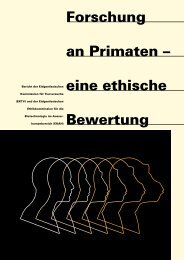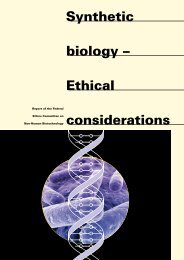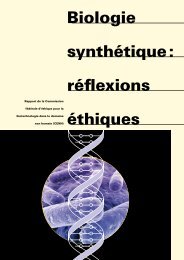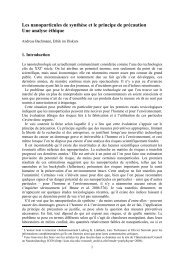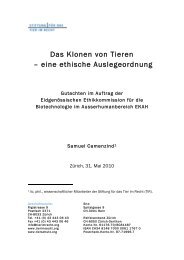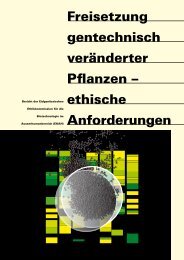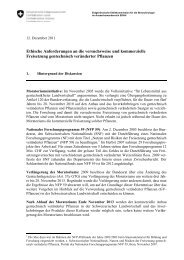Helmut Segner Fish Nociception and pain A biological perspective
Helmut Segner Fish Nociception and pain A ... - EKAH - admin.ch
Helmut Segner Fish Nociception and pain A ... - EKAH - admin.ch
- No tags were found...
Create successful ePaper yourself
Turn your PDF publications into a flip-book with our unique Google optimized e-Paper software.
er level responses such as avoidance learning. The translation of<br />
nociceptive signals into the experience of <strong>pain</strong> depends on a variety<br />
of factors, for instance, <strong>pain</strong> perception can be curtailed by stress,<br />
it can be exaceberated by anticipation, or already existing tissue<br />
damage can exaggerate the <strong>pain</strong> perception of additional noxious<br />
stimuli (hyperalgesia). There is a strong psychological component<br />
in <strong>pain</strong> perception, as evident, for instance, from the ability of<br />
placebo treatment to reduce <strong>pain</strong> (Wager et al. 2004), or from the<br />
fact that empathy for a person experiencing <strong>pain</strong> can induce <strong>pain</strong><br />
sensations in the observer (Singer et al. 2004).<br />
Our perception of <strong>pain</strong> is strongly driven by our own experience,<br />
<strong>and</strong> the question arises what <strong>pain</strong> actually means when we transfer<br />
this term to animals. The <strong>pain</strong> experienced by an animal will<br />
be qualitatively different to the <strong>pain</strong> sensation we experience. As<br />
pointed out by Rose (2007), most people would consider the use<br />
of the term “love” for describing the emotional situation of mating<br />
animals to be inappropriate – similarly, what we experience as <strong>pain</strong><br />
is not the same what an animal experiences when it is exposed<br />
to a noxious stimulus. This does not implicate that an animal is<br />
not able to feel <strong>pain</strong>, but it highlights that we must exercise some<br />
caution when using the term “<strong>pain</strong>” for animals. Along this line<br />
of thinking, the present text, when referring to animal <strong>pain</strong>, does<br />
not stick to the definitions of human <strong>pain</strong> as given by the IASP,<br />
which is focused on the quality of human <strong>pain</strong> experience. When<br />
we talk of <strong>pain</strong> in fish, we deal with a qualitatively different form<br />
of <strong>pain</strong> experience, probably a more “primitive” (in an evolutionary<br />
sense) or “simple” form of <strong>pain</strong> (“einfacher Schmerz” in the<br />
study of Wild 2012). For this underst<strong>and</strong>ing of <strong>pain</strong>, the definition<br />
as suggested by Molleny (1997) may be more appropriate than the<br />
human-focused IASP definition:<br />
“Animal <strong>pain</strong> is an aversive, sensory experience representing awareness<br />
by the animal of damage or threat to the integrity of tissues. It changes<br />
the animal’s physiology <strong>and</strong> behaviour to reduce or avoid the damage,<br />
to reduce the likelihood of its recurrence, <strong>and</strong> to promote recovery.”<br />
How can we know if an animal “feels” <strong>pain</strong>, how can we assess<br />
their subjective experiences when exposed to noxious stimuli<br />
(Bateson 1991)? In humans, assessment of <strong>pain</strong> experience often<br />
relies on verbal report of the individuals exposed to noxious stimuli,<br />
<strong>and</strong> this qualitative experience is then connected to quantifiable<br />
measurement parameters such as neuroimaging signals.<br />
To assess the capability of non-human animals for <strong>pain</strong> experience,<br />
as verbal record is not possible, research strongly relies<br />
on a comparative approach, that is we evaluate similarities <strong>and</strong><br />
continuities between structures <strong>and</strong> functions which are involved<br />
in <strong>pain</strong> perception in man to the corresponding structures <strong>and</strong><br />
functions in animals. This includes analogies <strong>and</strong> / or homologies<br />
of neuroanatomy, neurophysiology, <strong>and</strong> behavioural responses to<br />
<strong>pain</strong>ful stimuli. The interpretation of such data, however, can be<br />
equivocal; intuitively, it may still work for species being closely<br />
related to man such as primates, but it is getting increasingly<br />
difficult for evolutionary more distant species such as fish. Much<br />
of the controversial debate on the existence of <strong>pain</strong> perception<br />
in animals relates to this difficulty (Bateson 1991).<br />
The difficulties in assessing <strong>pain</strong> <strong>and</strong> underst<strong>and</strong>ing its nature<br />
are also reflected in the historical <strong>perspective</strong>s of <strong>pain</strong> (Brooks<br />
<strong>and</strong> Tracey 2005, Perl 2007). Aristotle (384–322 BC) classified<br />
<strong>pain</strong> as an emotion <strong>and</strong> this remained the dominating opinion for<br />
a long time. Originally, Galen (AD 130–201), <strong>and</strong> later Avicenna<br />
(AD 980–1037) <strong>and</strong> Descartes (AD 1596–1650), placed <strong>pain</strong> into<br />
the sphere of sensation, but a controversial discussion remained<br />
if <strong>pain</strong> is indeed an independent sensation with its own sense<br />
organs <strong>and</strong> pathways (specificity theory), or if <strong>pain</strong> sensation is<br />
the result of an intense activation of other sensory systems (intensity,<br />
pattern <strong>and</strong> gate theories) (cf. Perl 2007). One important<br />
argument why <strong>pain</strong> was considered to be not a specific sensation<br />
on its own was the fact that it can be induced by different types<br />
of stimuli (mechanical, physical <strong>and</strong> chemical), a feature that<br />
is different to other senses <strong>and</strong> apparently argues against the<br />
existence of specific “<strong>pain</strong> receptors”. In the course of the 20 th<br />
century, however, an increasing number of anatomical studies<br />
provided evidence for the existence of a distinct class of afferent<br />
nerve fibres that selectively respond to tissue injury, irrespective<br />
if the tissue injury is caused by a chemical, physical or mechanical<br />
factor (Sherrington 1906, Burgess <strong>and</strong> Perl 1967). Subsequent<br />
electrophysiological studies showed that activity in these afferent<br />
fibers correlates with <strong>pain</strong> behaviour <strong>and</strong> <strong>pain</strong> experience<br />
10 <strong>Fish</strong>. <strong>Nociception</strong> <strong>and</strong> <strong>pain</strong> | Contributions to Ethics <strong>and</strong> Biotechnology<br />
<strong>Fish</strong>. <strong>Nociception</strong> <strong>and</strong> <strong>pain</strong> | Contributions to Ethics <strong>and</strong> Biotechnology<br />
11



